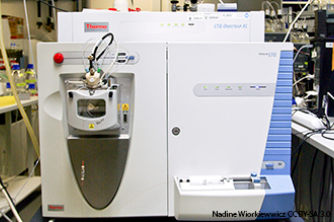Mass spectrometry is the dominant technology in the field of proteomics, enabling the identification and quantification of cellular proteins and their modified forms.
Instruct has 8 centres offering Mass Spectrometry across Europe. Navigate the map and click on the pins to discover centres near you.
Invented originally in the in the early 1900s, as a technology to study the mass of isotopes in molecules, mass spectrometry (MS) has evolved into a modern method that allows studying hundreds of thousands of molecules from complex systems such as living cells. Within Instruct, mass spectrometry is employed in particular to study proteins. It is widely applicable, including to assemblies as large as viruses, containing intrinsically disordered regions, associated with membranes, or populating a range of oligomeric states. It enables the determination of protein identity, abundance, modifications (proteomics), protein shape and topology (ion mobility), inter-subunit connectivity, and equilibrium dynamics (native mass spectrometry). Combinations of these different mass spectrometry approaches allow studying the quaternary structure level as well as the individual proteins and this makes mass spectrometry a vital bridge between technologies and structural biology.
Native mass spectrometry is a tool that allows the structural investigation of protein complexes. It does not provide a structural model in atomic detail, but the sensitivity, speed, selectivity, unlimited mass range and accuracy of the analysis provides important advantages over other techniques. It’s sensitivity allows the investigation of endogenous protein complexes, and another major benefit of the method is that it can simultaneously analyse several species in one spectrum. If there is a heterogeneous population of protein complexes present in one sample, the one of interest can be specifically isolated for further studies.
Within this research field electrospray ionisation is the most popular technique to ionise the proteins/protein complexes of interest. It is a gentle ionisation method allowing the preservation of quaternary protein structures. Normally the protein complex is sprayed from a volatile buffer, compatible with the electrospray process.
A range of mass spectrometric approaches can be applied to investigate the biological systems. The exact mass of proteins can be determined, but also the stoichiometry of an assembly, its stability, dynamical behavior, conformation, subunit interaction sites and topological arrangement of the individual proteins within a complex.
Native ion mobility mass spectrometry (IMMS) provides complementary analysis to the separation of the ions based on mass, they are also separated according to their physical size. Typically, ions with a larger cross section (volume) exhibit longer drift times in the gas-filled ion mobility chamber. Therefore, IMMS can reveal direct information regarding the shape and conformation of a protein complex. Up to now, several IMMS studies have indicated that solution phase structures are often largely retained in the gas-phase, making this method potentially a valuable new tool in structural biology. The size measurements of the ions obtained by IMMS can then be used with computational modeling to generate refined structural models for the protein complex in question.
Mass spectrometry is the dominant technology in the field of proteomics, enabling the indentification and quantification of cellular proteins and their modified forms. In Instruct we correlate our structural insights into protein assemblies with this fundamental information about the individual chains. We offer access to state-of-the-ar proteomics facilities, including identification and quantification of proteins, peptides and post-translational modifications.
